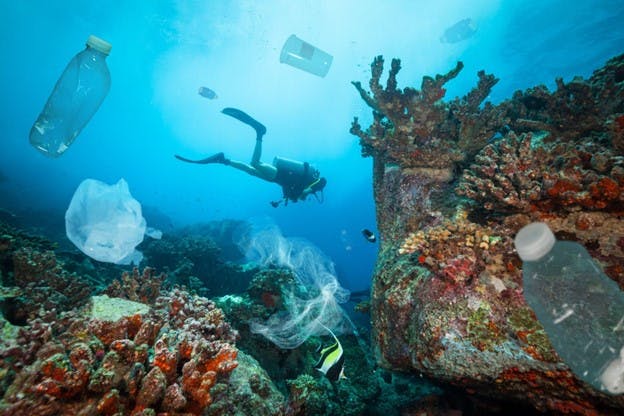🌟 New Arrival! Upgrade Your Water with Our Advanced Pitcher Filter. Shop Now
April 2024
Forever Plastics: Impact, Innovations, and Solutions
Key Takeaways
- Forever plastics, containing toxic PFAS compounds, persist in the environment for many years, posing significant health and environmental risks.
- PFAS exposure through contaminated food and water can lead to various health issues, including increased cholesterol levels and heightened cancer risk.
- Despite growing concerns, regulations controlling the production and use of forever plastics are lagging behind, worsening the challenge of effectively regulating these harmful materials.
- Mitigation strategies such as investing in home water filters and supporting businesses promoting PFAS-free alternatives are essential to reducing forever plastics and PFAS exposure.
Plastics are the most common synthetic materials we use every day. Our relationship with plastics dates back to 1907, when Belgian scientist Leo Baekeland pioneered the first plastic. Since then, plastics have found their way into every corner of our lives, from fast-food packaging to phones to water bottles to clothing.
While plastics are affordable and easy to manufacture compared to other materials, their impact on the environment and your health cannot be underestimated. One class of plastics that’s slowly becoming a menace is forever plastics. Unlike conventional plastics, forever plastics are resistant to degradation, persisting in the environment for years and harming natural ecosystems.
In this article, we’ll unravel the scientific nature of forever plastics, their impact on health and the environment, and sustainable solutions to reduce their use. Let’s dive in.
What Are Forever Plastics?
Forever plastics are a group of plastics made from highly durable and degradation-resistant compounds. They are engineered to resist heat, water, grease, and other substances. Forever plastics find utility in many applications that demand their durability. These plastics are found in non-stick cookware (Teflon), textiles, food packaging containers, food wrappers, stain-resistant carpets, and more. However, the same quality that makes them desirable also makes them harmful.
Forever plastics are named so because they contain chemical compounds referred to as “forever chemicals.” Forever chemicals are extremely resistant to degradation and usually last in the environment for thousands of years. In the case of forever plastics, the toxic chemicals used in their manufacturing are called per- and poly-fluoroalkyl substances (PFAS). PFAS are harmful fluorine-based compounds. They are resistant to chemical, heat, and microbial breakdown.
There are more than 10,000 types of PFAS. Perfluorooctanoic Acid (PFOA) and perfluorooctane sulfonate (PFOS) are the most popular ones. Over the years, PFAS levels in the environment have risen due to the increased production to meet global demand amidst the growing population. Forever plastics account for a huge part of the increase. PFAS contamination is now prevalent in many areas across the globe.
In the United States, studies show that over 200 million people may potentially have PFAS in their drinking water at concentrations that could affect their health. Many of these people are unaware of the dangers of PFAS exposure to their health. Without the right measures, the use of PFAS will continue to threaten the safety of our health and environment. Let's explore the effects of PFAS.
What Are the Health Effects of Forever Plastics?
Many people are exposed to PFAS through food and water contaminated with PFAS particles from forever plastics. The amount of PFAS in the body builds up over time since more PFAS is absorbed than the amount eliminated, leading to toxic levels of the compound. Exposure to PFAS is a growing public health concern.
A report by the National Health and Nutrition Examination Survey (NHANES) revealed that 97% of Americans have PFAS in their blood. The effects of PFAS are long-term, so PFAS contamination may be slowly breeding a hidden epidemic, but more studies are needed to ascertain this.
PFAS poses several health risks, such as:
- Increasing cholesterol levels
- Increasing the risk of certain cancers like kidney, prostate, and testicular cancers
- Reducing the body’s immune system and vaccine response
- Causing hormonal imbalance
- Reducing fertility and causing high blood pressure in pregnant women
- Affecting normal development in children
Ultimately, the health effects of PFAS on every person depend on the dose and duration of PFAS exposure. Currently, no treatment is available for removing PFAS from the body, so reducing exposure is the best way to avoid future health problems.

What Are the Environmental Impacts of Forever Plastics?
The environment continues to suffer the devastating effects of plastic pollution. Forever plastics can stay in the environment for thousands of years, contaminating natural habitats and disrupting ecosystems. Most plastics end up in landfills and large water bodies.
These plastics are broken down into tiny bits called microplastics. PFAS-containing microplastics can be mistaken for food or swallowed accidentally, especially by fish and other aquatic animals. They may cause both physical and chemical harm, resulting in the death of many animals and disrupting the balance of natural ecosystems. As PFAS levels accumulate in the food chain over time, many more animals, and even humans, are exposed to the toxic effects of PFAS.
Apart from their ecological effects, plastic pollution can accelerate climate change. The production and disposal of plastics have been shown to release greenhouse gasses into the atmosphere. Plastics are responsible for about 4% of the total[1] greenhouse gas emissions. PFAS compounds in forever plastics are especially destructive to the ozone layer due to their fluorine composition.
Regulating Forever Plastics: Are Laws Keeping Pace With Pollution?
In the past few years, many people have raised concerns about the negative health and environmental impacts of forever plastics. However, regulations controlling the production and use of forever plastics are lagging. Governments around the world are still struggling to find suitable solutions to the PFAS problem. The U.S. is leading the charge in establishing laws to keep PFAS in check.
The U.S. Environmental Protection Agency (EPA) has listed 189 PFAS compounds in the Toxics Release Inventory. Being listed in this inventory requires manufacturers to disclose any releases of these PFAS into the environment. Even with these provisions in place, there are still many loopholes that allow businesses to bypass listing requirements.
In 2021, EPA unveiled plans to regulate two of the most notorious PFAS chemicals, PFOA and PFOS, in drinking water and consumer products. While it may take several years before these regulations are formally implemented, it’s a step in the right direction.
The Biden administration has pledged to address PFAS contamination through a series of measures. Among them, the government intends to regulate the chemicals in drinking water, classify PFAS as hazardous substances under the federal Superfund law, discontinue procurement of certain PFAS-containing products, and allocate additional funding for research into these chemicals.
Amidst the ongoing regulatory tussle, chemical companies manufacturing PFAS products are already facing massive class action lawsuits. 3M, Chemours, and DuPont have been the subject of numerous lawsuits concerning suspected PFAS contamination. The companies have paid billions of dollars as settlement for damages arising from PFAS contamination.
How Can You Reduce Forever Plastics and PFAS Exposure?
Governments and other regulatory bodies may help to reduce the production and use of plastics, but that’s not enough to eliminate PFAS exposure. Here are five strategies that can help you reduce PFAS contamination.
1. Invest In a Home Water Filter
Drinking water is the most common way to accidentally consume PFAS chemicals. Public water systems are still behind in providing clean, PFAS-free drinking water. According to a recent study by the Environmental Working Group, all 50 states, Washington, D.C., and four territories had their water systems contaminated with PFAS.[1] From California to New York, drinking tap water in many regions across the U.S. can expose you to toxic PFAS.
Luckily, home water filters are now widely available and affordable enough for the average household. Water filters purify drinking water, eliminating toxic compounds like PFAS. Reverse osmosis and activated carbon water filters excel in removing PFAS compounds, among other toxins. Investing in a good water filter can help you reduce your family’s exposure to PFAS.
2. Boil Your Drinking Water
A recent report in Environmental Science & Technology Letters indicates that boiling tap water rich in minerals for 5 minutes may decrease nanoplastics and microplastics (NMPs) exposure by as much as 90%. Yet, it remains uncertain whether boiling drinking water effectively eliminates PFAS compounds.
3. Minimize Use of Single-Use Plastics
It might not be easy to eliminate plastics, but limiting their use goes a long way toward reducing PFAS pollution. Always opt for reusable plastic alternatives like glass water bottles or stainless steel packaging materials. This will reduce the pollution caused by dumping used plastics into the environment.
4. Choose PFAS-Free Products
Rising consumer awareness is making many brands adopt sustainable alternatives to PFAS-containing forever plastics. When purchasing items like cookware or packaging materials, choose the ones labeled as PFAS-free by the manufacturers. PFAS-free products may be made of other materials or even plastics that are less harmful to the environment compared to forever plastics.
5. Support Businesses That Use PFAS-Free Alternatives
Supporting businesses that advocate for a PFAS-free environment will help these businesses thrive, raise awareness, and get more people on board. Other businesses are likely to follow suit to appeal to the customers. While it takes time, this will encourage many businesses to phase out forever plastics and replace them with environmentally friendly options.
Tackling Forever Plastics: What Substitutes Are Available?
There are several sustainable and non-toxic alternatives to PFAS-containing forever plastics. Here are five of the best substitutes for forever plastics.
1. Bioplastics
Bioplastics are made from environmentally friendly biological materials such as biomass from sugar cane or cellulose. Unlike forever plastics, bioplastics are degradable, reducing any negative impacts on the environment.
2. Bio-Based Composites
Bio-based composites are made from biodegradable resins and natural fibers. They are great substitutes for forever plastics because they are just as durable, while also being biodegradable. They can be used to manufacture consumer products as well as construction materials.
3. Paper and Cardboard
Paper and cardboard are sustainable packaging alternatives for food and other products. These materials are renewable and recyclable, making them suitable for packaging fast-moving products.
4. Mycelium-Based Materials
Mycelium-based materials are made from the roots of some fungi. They are lightweight and can be shaped easily. They can replace forever plastics in packaging, construction, and insulation materials.
5. Natural Fibers
Natural fibers like hemp and cotton can replace many plastics. They can be used to produce reusable packaging materials with a lower environmental footprint, preventing PFAS pollution.

Get Cleaner, PFAS-Free Drinking Water
Forever plastics are common in many household, industrial, and automotive products. While they serve many useful purposes, forever plastics introduce toxic PFAS compounds into the environment. PFAS is harmful to both humans and natural ecosystems. PFAS contamination is a growing problem across the United States. Studies show that water sources in many states across the U.S. contain toxic levels of PFAS. But there’s a solution to the problem.
Home water filters can help you avert the dangers of PFAS exposure. Water filters work behind the scenes to ensure that your water is cleaner, fresher, and has lower levels of several contaminants, including PFAS. Ready to take a step towards a healthier future?
Experience unparalleled water purity with our HomeWater UPSTREAM™ 4-Stage Whole Home Water Filter. Harnessing the power of advanced catalytic carbon, this filter eliminates several contaminants, from pesticides and heavy metals to PFOS/PFAS and microplastics. Simple to install, electricity-free, and compact, it seamlessly integrates into your home, delivering pristine water quality while occupying just 8 square inches of space.